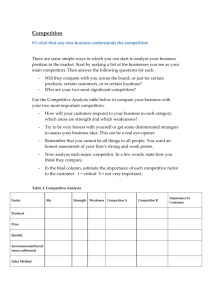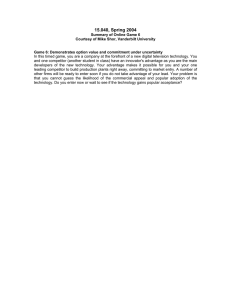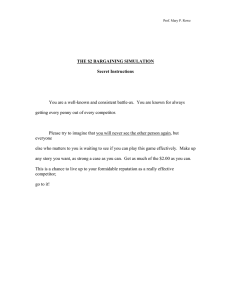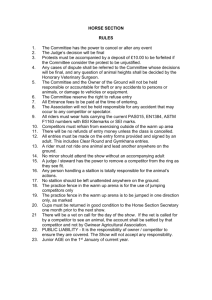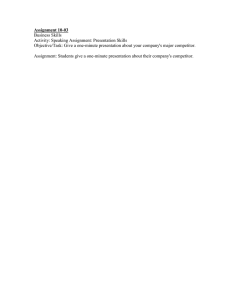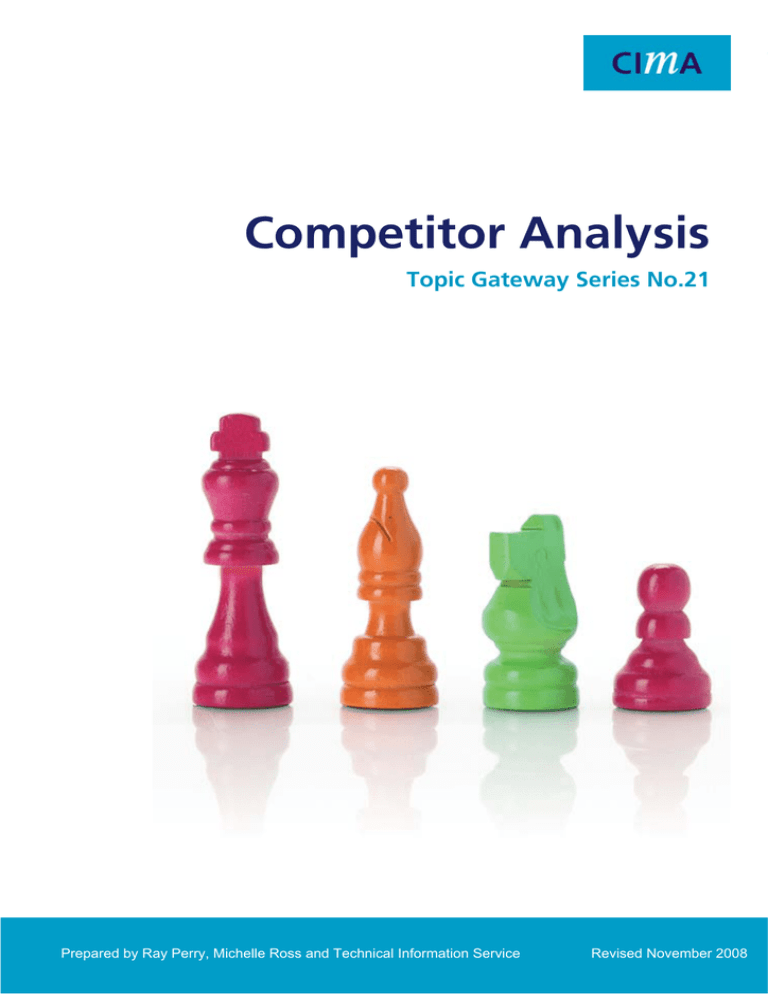
Topic Gateway Series
Competitor Analysis
Competitor Analysis
Topic Gateway Series No.21
1
Prepared by Ray Perry, Michelle Ross and Technical Information Service
Revised November 2008
Topic Gateway Series
Competitor Analysis
About Topic Gateways
Topic Gateways are intended as a refresher or introduction to topics of interest
to CIMA members. They include a basic definition, a brief overview and a fuller
explanation of practical application. Finally they signpost some further resources
for detailed understanding and research.
Topic Gateways are available electronically to CIMA members only in the CPD
Centre on the CIMA website, along with a number of electronic resources.
About the Technical Information Service
CIMA supports its members and students with its Technical Information Service
(TIS) for their work and CPD needs.
Our information and accounting specialists work closely together to identify or
create authoritative resources to help members resolve their work related
information needs. Additionally, our accounting specialists can help CIMA
members and students with the interpretation of guidance on financial reporting,
financial management and performance management, as defined in the CIMA
Official Terminology 2005 edition.
CIMA members and students should sign into My CIMA to access these services
and resources.
The Chartered Institute
of Management Accountants
26 Chapter Street
London SW1P 4NP
United Kingdom
T. +44 (0)20 7663 5441
F. +44 (0)20 7663 5442
E. tis@cimaglobal.com
www.cimaglobal.com
2
Topic Gateway Series
Competitor Analysis
Competitor Analysis
Definition
Competitor analysis is defined as the:
‘Identification and quantification of the relative strengths and weaknesses
(compared with competitors or potential competitors), which could be of
significance in the development of a successful competitive strategy.’
CIMA Official Terminology Guide 2005
Competitor analysis involves understanding and analysing businesses which
compete directly or indirectly with your business in at least one market, product
category or service. The main process involved in competitor analysis is to identify
strengths and weaknesses of competitors, and the opportunities and threats for
your business.
It is common for the terms ‘competitor analysis’ and ‘competitive intelligence’ to
be used interchangeably. However, competitive intelligence tends to cover a
broader view of the competitive environment. It includes all the factors that could
affect profits, for example, new technology, changing consumer tastes and
general economic trends.
The Society of Competitive Intelligence Professionals (SCIP) defines competitive
intelligence as ‘a systematic and ethical programme for gathering, analysing and
managing external information that can affect your company’s plans, decisions
and operations.’
Context
In the current syllabus, CIMA students will learn and may be examined on this
topic in Paper 6, Management Accounting, Business Strategy.
Related concepts
Cost planning and analysis for competitive advantage; marketing; product
management; added value; brand management; strategic planning; position
appraisal and analysis.
3
Topic Gateway Series
Competitor Analysis
Overview
Competitor analysis is an important requirement in any business plan because it:
•
reveals the firm’s competitive advantage or disadvantage relative to its
competitors
•
provides insight into competitors’ strategies – past, present and future
•
assists in developing future competitive strategies to establish advantages
over your competitors.
The main rationale for competitor analysis is to give key company decision
makers a broader understanding of the competition. This understanding should
assist management in assessing the firm’s strengths and weaknesses. It should
also help to ascertain threats and opportunities to the firm from its industry
environment.
According to Wilson (1994), competitor analysis ‘should be a central element in
management planning and control, with detailed attention being paid to each
competitor’s objectives, resources and competitive stance, as well as to individual
elements of its strategy.’
Application
The importance of competitor analysis
It can be argued that knowing your key competitors and their strategies are two
of the most important factors in gaining greater market share. Once the
competitors and their strategies have been identified, the following questions
need to be considered:
1. In which areas are we most vulnerable to our competitors?
2. What can we do realistically to reduce this vulnerability?
4
Topic Gateway Series
Competitor Analysis
Targeted intelligence is one of the most commonly used methods in undertaking
competitor analysis. It focuses on what a business needs to know about its
competitors. According to EMP Intelligence Service, targeted intelligence can help
an organisation to:
•
increase sales
•
reduce competitors’ sales
•
obtain higher prices
•
decrease own costs
•
reduce competitors’ profitability
•
increase the costs of competitors
•
improve defensive strategies
•
identify joint venture or takeover opportunities.
Core competencies
Core competencies provide the foundations for developing a competitive
advantage. If a company is unable to identify distinctive competencies, they may
overlook attractive opportunities and pursue poor ones.
However, the idea of distinctive competence, which differentiates one business
from another, is no longer enough to characterise a good business. The current
business climate is driven by technological development and quick reactions to
changing environments. Consequently, a competitive advantage based on a
singular competence is unlikely to be sustainable for very long.
Ultimately, very few businesses enjoy a monopoly on a market. Comparable
products and services are almost always offered by other organisations.
5
Topic Gateway Series
Competitor Analysis
External influences
Porter (1980) identified five external influences which impact on the extent of
actual and potential competition in any industry. Known as ‘Porter’s five forces,’
in aggregate they can determine organisations’ ability to earn a profit within an
industry. These are:
1. Potential entrants.
2. Suppliers.
3. Substitutes.
4. Buyers.
5. industry competitors.
Figure 1 shows the impact of varying levels of competitor action on the profits of
a business. Such competitor action may include:
•
price cuts
•
launching a rival product
•
aggressive expansion of production which reduces the firm’s market sales
•
inclusion of costly modifications to the product which rival firms must also
make.
Figure 1: Impact of competitor responses on profit
When conducting competitor analysis it is essential to consider the effect that
external influences and competitor action may have on your profit.
6
Topic Gateway Series
Competitor Analysis
The competitor
Essentially, business competitors can be broken down into the following four
categories (Weiss, 2002).
1. Organisations offering the same product or service.
2. Organisations offering similar products or services.
3. Organisations that could offer the same or similar products or services in the
future.
4. Organisations that could remove the need for a product or service
Kotler (1997) identifies four levels of competitor:
Brand competitors. Organisations which offer similar products to the same
customers and which have a similar size and structure. Examples include:
•
Pepsi and Coca-Cola
•
Unilever and Proctor & Gamble.
Industry competitors. Suppliers who produce similar goods but who are not
necessarily the same size or structure. They may compete in a more limited area
or product range. Examples include:
•
British Airways and Singapore Airlines
•
Unilever ice cream and Mars ice creams
•
Nestlé and Cadbury.
Form competitors. Competitors who compete for the same needs, although
they are technically quite different. Examples include:
•
speedboats and sports cars
•
book publishers and software manufacturers.
Generic competitors. Competitors who compete for the same income.
Examples include:
•
home improvements and golf clubs
•
foreign vacations and new homes.
7
Topic Gateway Series
Competitor Analysis
How to carry out competitor analysis
EMP Intelligence Service identified the five P’s of competitor intelligence as key
requirements to undertake competitor analysis effectively.
Plan
Right competitor intelligence strategy.
People
Right people and skills.
Position
Integration, support and involvement.
Processes
1. Key intelligence requirements.
2. Right sources.
3. Right products and processes.
4. Right communication.
Performance
1. Measurement.
2. Feedback.
In addition, there may be four stages in monitoring competitors, known as the
four Cs:
1. Collecting the information (with a first stage - deciding what to collect).
2. Converting information into intelligence (CIA - collate and catalogue it,
integrate it with other pieces of information and analyse and interpret it).
3. Communicating the intelligence.
4. Countering any adverse competitor actions, i.e. using the intelligence.
Gathering competitor intelligence
One mistake many people make is to start by collecting information without
thinking how the information will be used. They should first identify the key
areas of concern for the decision makers requesting the information, and aim to
satisfy these. They need to focus and plan the search, rather than collect
information in a random or haphazard manner. Collected data must aim to
answer the actual intelligence needs of the business (often termed key
intelligence topics, or KITs).
8
Topic Gateway Series
Competitor Analysis
A key indicator of a competitor’s future actions, plans and strategies is the
evidence it leaves in the market place. As a result, there is a vast amount of
information on which competitor analysis can be based. The list below highlights
a number of sources. Fleisher and Bensoussan (2002) provide a comprehensive
list of information sources used in competitor analysis:
•
financial data
•
publications
•
competitor websites
•
industry websites and publications
•
trade exhibitions
•
press releases
•
annual reviews
•
professional bodies
•
promotional material
•
information packs
•
brochures
•
database searches e.g. Factiva, Lexis-Nexis, Dun and Bradstreet
•
observation
•
word of mouth.
From information to intelligence
Much of the data collected is likely to be irrelevant. However, each piece can help
build up the complete picture and needs to be collated into a central resource.
Ideally the information should be indexed and catalogued so that new
information can be quickly linked to similar information.
Finally, the relevance and importance of each piece of information needs to be
interpreted and analysed – on its own and in conjunction with other information.
This is where information starts to become intelligence.
Communicating the intelligence
Competitor intelligence needs to be evaluated. It is then selectively
communicated to those who make decisions based on the actions or likely
actions of customers, suppliers and others.
9
Topic Gateway Series
Competitor Analysis
The most common way of presenting this information is to compare and contrast
your business with its main competitors using a SWOT analysis. A SWOT analysis
provides a bullet point summary of your business’ strengths, weaknesses,
opportunities and threats. Figure 2 provides an example of what a SWOT analysis
might include. However, this information can also be presented in the form of
matrixes, PEST (Political, Economic, Social and Technological) analysis, scenario
analysis, inferential scanning and others.
Figure 2: Example of a SWOT analysis
Strengths
Weaknesses
•
•
•
•
•
•
•
•
Specialist marketing expertise.
New innovative product or
service.
Location of your business.
Cost advantage through
proprietary know-how.
Quality process and procedures.
Strong brand or reputation.
•
•
•
•
Lack of marketing expertise.
Undifferentiated products and
services (i.e. in relation to your
competitors).
Location of your business.
Competitors have superior access
to distribution channels.
Poor quality goods or service.
Damaged reputation.
Opportunities
Threats
•
•
•
•
•
•
•
•
Developing market (China, the
internet).
Mergers, joint ventures or
strategic alliances.
Moving into new attractive
market segments.
A new international market.
Loosening of regulations.
Removal of international trade
barriers.
A market led by a weak
competitor.
•
•
•
•
A new competitor in your home
market.
Price war.
Competitor has a new, innovative
substitute product or service.
New regulations.
Increased trade barriers.
Source: adapted from www.valuebasedmanagement.net
10
Topic Gateway Series
Competitor Analysis
From competitor analysis to business strategy
The ultimate objective and final part of conducting a competitor analysis is to
ensure that the intelligence collected is incorporated into the organisation’s
decision making and strategic planning process.
Failing to monitor competition
Failing to monitor your competition can take two forms. The first is failing to
monitor your competition effectively in one or more of the following ways (EMP
Intelligence Service, 2004):
•
choosing the wrong target
•
selecting the wrong sources
•
collecting too much information
•
not building up a network.
The second is to ignore market competition altogether.
The result of an ineffective or non-existent approach to competitor analysis is
likely to lead to sub-optimal performance. It will also result in a greater exposure
to aggressive and unexpected moves from competitors.
Other consequences of failing to monitor competition include:
•
an increased likelihood of the enterprise being taken by surprise
•
the risk of being a follower rather than a leader
•
focusing only on short-term rather than fundamental long-term issues.
The case study below highlights the consequence of failing to monitor
adequately the competition in the case of Nike.
11
Topic Gateway Series
Competitor Analysis
Case Study
In 1983 Reebok developed a strategy to market fashionable athletic footwear
to women which generated explosive growth. Reebok relied on products being
image driven while Nike’s focus was on performance driven products.
For five years, Nike ignored Reebok’s success and viewed it as an aberration. As
a result, Nike lost significant market share: by 1988 Reebok’s market share was
27% as opposed to Nike’s 23%.
Nike failed to pay sufficient attention to its competitors. This led to loss of
market position, layoffs and a major management shake-up.
Source: Wilson and Gilligan, 1997
Other considerations
It should be noted that individual competitors are part of the much larger picture
which makes up an industry. Monitoring competitor activity can result in
short-term decision making, but a more holistic approach is needed to develop
robust longer term strategies. The overall business environment must be covered,
including the whole industry, suppliers, customers, technical advances and the
economy generally.
The information required to undertake a competitor analysis is often not readily
available. Information may have to be derived from consumers’ preferences using
market surveys, or through the behaviour of competitors. This may be more
difficult, particularly if a rival does not fully understand its own behaviour.
Summary
In summary, competitor analysis is a strategic business tool that provides
organisations with the knowledge to develop business strategies. These will allow
them to build a sustainable advantage in the industry in which they operate.
12
Topic Gateway Series
Competitor Analysis
Further information
Articles
Full text from Business Source Corporate through My CIMA
www.cimaglobal.com/mycima
[Accessed 13 November 2008]
Brooks, Mike. Body of Evidence. (334 PDF KB). Financial Management, March
2005, pp 14-16
Available from: www.cimaglobal.com/financialmanagement
[Accessed 13 November 2008].
Capron, L and Chatain, O. Competitors’ resource-oriented strategies: acting on
competitors’ resources through interventions in factor markets and political
markets. Academy of Management Review, January 2008, Volume 33, Issue 1,
pp 97-121
Drohan, W.M. and O'Connor, K. Competitor analysis can give your association
the edge. Association Management, January 1998, pp 103-106
Hussey, D. Sources of information for competitor analysis. Strategic Change,
September/October 1998, Volume 7, Issue 6, pp 343-356
McManus, J. and Botten, N. Competitive analysis: thinking beyond stage one.
Management Services, Summer 2006, Volume 50, Issue 2, pp 10-15
Wilson, R. Competitor analysis. Financial Accounting, April 1994, Volume 72,
Issue 4, pp 24-25
Articles
Abstract only from Business Source Corporate through My CIMA
www.cimaglobal.com/mycima
[Accessed 13 November 2008]
Bloodgood, J.M. and Bauerschmidt, A. Competitive analysis: do managers
accurately compare their firms to competitors? Journal of Managerial Issues,
Winter 2002, Volume 14, Issue 4, pp 418-434
Channon, D.F. Competitor analysis. Blackwell Encyclopedic Dictionary of Strategic
Management, 2005, pp 1-50
Fahey, L. Invented competitors: a new competitor analysis methodology. Strategy
and Leadership, 2002, Volume 30, Issue 6, pp 5-12
13
Topic Gateway Series
Competitor Analysis
Books
CIMA Official Terminology. (2005). Oxford: CIMA Publishing (in partnership with
Elsevier)
Brennan, R. et al. (2007). Contemporary strategic marketing. 2nd ed.
Basingstoke: Palgrave Macmillan
Fleisher, C.S. and Bensoussan, B. (2002). Strategic and competitive analysis:
methods and techniques for analysing business competition. Harlow: Prentice
Hall
Haag, S. (2006). Management information systems for the information age. 3rd
ed. New York: McGraw-Hill Ryerson
Hussey, D.E. and Jenster, P. (2000). Competitor analysis: turning intelligence into
success. Chichester: Wiley. (CBI Series in Practical Strategy)
Porter, M. E. (1980). Competitive strategy, techniques for analysing industries
and competitors. Columbus, OH: The Free Press.
Proctor, T. (2008). Strategic marketing: an introduction. 2nd ed. London:
Routledge
Course material
EMP Intelligence Service. (2004). Know your competitors: competitor intelligence
analysis
14
Topic Gateway Series
Competitor Analysis
Websites
Competitive Intelligence for Business Success (AWARE)
AWARE provides competitor profiles and a competitor monitoring
service. It helps clients improve and build their own Competitive
Intelligence (CI) processes so that they become self-reliant. AWARE
offers bespoke CI training courses, and a CI Audit service. The website
carries CI white papers, case studies and sample reports.
Available from: www.marketing-intelligence.co.uk
[Accessed 13 November 2008]
The Society of Competitive Intelligence Professionals (SCIP)
SCIP is a global non-profit membership organisation for everyone
involved in creating and managing business knowledge. It provides
education and networking opportunities for business professionals
working in competitive intelligence.
Available from: www.scip.org
[Accessed 13 November 2008]
www.valuebasedmmanagement.net
Management portal specifically aimed at the information needs of
senior executives with an interest in value creation, managing for value
and valuation. It provides learning materials explaining management
methods, models and theories on strategy, performance, finance,
valuation, change, corporate governance, communication, marketing,
leadership and responsibility, with links to additional resources.
Available from: www.valuebasedmanagement.net
[Accessed 13 November 2008]
White papers
Weiss, A. (2001). AWARE. Competitive intelligence: tactical information
or strategic wisdom?
First published in 2006 by:
No responsibility for loss occasioned to any person acting or refraining from
action as a result of any material in this publication can be accepted by the
authors or the publishers.
The Chartered Institute of
Management Accountants
26 Chapter Street
London SW1P 4NP
United Kingdom
All rights reserved. No part of this publication may be reproduced, stored
in a retrieval system, or transmitted, in any form or by any means method
or device, electronic (whether now or hereafter known or developed),
mechanical, photocopying, recorded or otherwise, without the prior 15
permission of the publishers.
Printed in Great Britain
Permission requests should be submitted to CIMA at tis@cimaglobal.com
Copyright ©CIMA 2006


